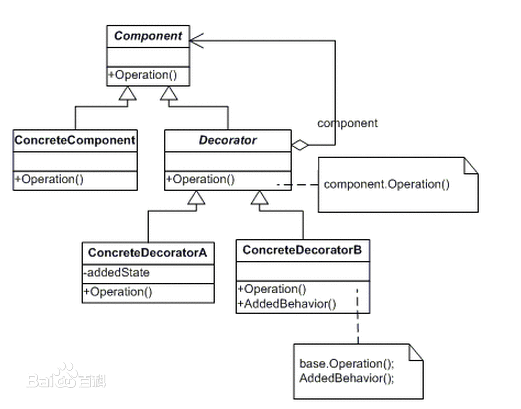装饰者模式:动态地将责任附加到对象上。若要扩展功能,装饰者提供了比继承更有弹性的替代方案。
适用范围:
1. 需要扩展一个类的功能,或给一个类添加附加职责。
2. 需要动态的给一个对象添加功能,这些功能可以再动态的撤销。
3. 需要增加由一些基本功能的排列组合而产生的非常大量的功能,从而使继承关系变的不现实。
4. 当不能采用生成子类的方法进行扩充时。一种情况是,可能有大量独立的扩展,为支持每一种组合将产生大量的子类,使得子类数目呈爆炸性增长。另一种情况可能是因为类定义被隐藏,或类定义不能用于生成子类。
UML图:

测试代码:
我们创建一个Toy抽象类,然后来生产不同的玩具,并为它加上各种功能。
#include <iostream>
#include <string>
using namespace std;
class Toy {
public:
virtual string getDescription() = 0;
};class Duck : public Toy {
public:
string getDescription(){ return "I'm a simple Toy-Duck. "; }
}; 接着是装饰类的基类,它包含Toy基类的指针,以便访问到我们的玩具鸭:
class Decorator : public Toy {
public:
Decorator(Toy* t) : toy(t){}
protected:
Toy* toy;
};创建形状装饰者和发声装饰者:
class ShapeDecorator : public Decorator {
public:
ShapeDecorator(Toy* t) : Decorator(t){}
string getDescription() {
return toy->getDescription.append("Now I have new shape. ");
}
};class SoundDecorator : public Decorator {
public:
SoundDecorator(Toy* t) : Decorator(t){}
string getDescription() {
return toy->getDescription.append("Now I can quack. ");
}
};好了,我们在main函数中测试一下:
int main()
{
Toy *toy = new Duck();
cout << toy->getDescription();
toy = new ShapeDecorator(toy);
cout << toy->getDescription();
toy = new SoundDecorator(toy);
cout << toy->getDescription();
return 0;
} 让我们再关注一条十分重要的设计原则:
对扩展开放,对修改关闭。






















 1628
1628











 被折叠的 条评论
为什么被折叠?
被折叠的 条评论
为什么被折叠?








